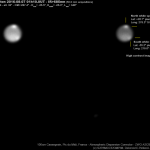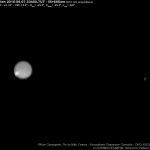From August 6th to 9th, 2016, I went back to the Pic du Midi Observatory for a second planetary mission with the 1 meter telescope. It has been a great success especially with Neptune storms imaging!
For this new mission, we were three with Marc Delcroix and Jean-Philippe Cazard (the editor of our future book Planetary Astronomy). The main target was imaging Uranus and Neptune storms. A smaller part of the mission has been dedicated to Saturn and Mars that were visible shortly after sunset.
Uranus and Neptune are currently two favoured objects for advanced planetary observers, because their observation offers a real opportunity of producing a work of scientific value. Storms on Uranus are numerous, but very small most of the time and today not within amateur reach. From time to time however, a bigger thunderstorm can appear (last time in 2014), it’s then accessible by photography with telescopes from around 300 mm (12″). Although Neptune’s apparent size is only two third that of Uranus, it paradoxically presents a more intense and more accessible storm activity (possibly with only 250 mm (10″)! ). Successful infrared images systematically show brighter zones at least in its southern hemisphere (which is actually in its early ~40 terrestrial years summer) – please read this older article on the blog: Neptune, the new amateur boundary? However bright spots can be caught at other latitudes and from this point of view the Pic results are spectacular!
Neptune results
(click on all images below for full resolution)
We were blessed with excellent conditions, especially during the night from 7 to 8 August. The 1 meter telescope is so impressive that most of the storms were visible directly on the screen during raw recordings! Imaging is mostly done in near infrared with the Baader IR 685. These images have been processed by Marc.
- August 7th: a storm at 40°N (upper side) and another one in the south hemisphere (lower right)
- August 8th: with exceptional seeing, a storm at usual S. temperate latitudes.
- August 9th: spectacular storm right in the middle of the disk!
- In true color RGB, the storm is still visible…
Take a look as well as those animation made by Marc!
WinJupos globe animation on August 8th (integrated data animated as a map)
“True” animation on August 9th (different images)
WinJupos globe animation on August 9th (integrated data animated as a map)
Uranus results
We observed only once but with none the less obtained what looks to be the best IR image of Uranus taken at the Pic. The belt system is well visible and a brighter polar region dominates. Unfortunately no storm looks active… This image has been processed by myself. You can see here a moon animation made by Jean-Philippe from same data.
Saturn results
Saturn was not observable in good conditions but some nice images have been made in infrared and methane. The polar hexagone is visible. Processing by Marc.
And one result on Mars…
Even less observable than Saturn, and unfortunately without atmospheric dispersion corrector. Still we can see the morning shadowy summits of the Tharsis volcanoes at left, and the fall north polar hood on the RGB image (Mars passed its northern fall equinoxe in early July). Processing by myself.












4 Comments
Thanks Federico :)
My greatest compliments! Very fine images
I’m waiting for other observative sessiones
Federico
Thanks Piero :)
Thank you Christophe for your excellent imaging. Very exciting the Neptune results,
You lucky to stay at Pic du Midi!
Best regards
Piero